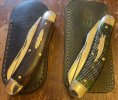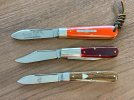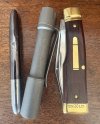-
The BladeForums.com 2024 Traditional Knife is ready to order! See this thread for details: https://www.bladeforums.com/threads/bladeforums-2024-traditional-knife.2003187/
Price is$300$250 ea (shipped within CONUS). If you live outside the US, I will contact you after your order for extra shipping charges.
Order here: https://www.bladeforums.com/help/2024-traditional/ - Order as many as you like, we have plenty.
You are using an out of date browser. It may not display this or other websites correctly.
You should upgrade or use an alternative browser.
You should upgrade or use an alternative browser.
Lets talk GEC!
- Thread starter rockgolfer
- Start date
Oldy
Gold Member
- Joined
- Aug 22, 2022
- Messages
- 2,039
I find my 88s comfortable in hand, and with a more useful combination of blades that the standard Trapper:
View attachment 2938624
You guys don't have powder puffs hands like myself,that lambsfoot just sits high I wouldn't want to use it for longer than a few minutes ,now the 86 I can go awhile lol.Ditto, no problems in hand at all.
The lambsfoot does sit high. I lowered it a shade on both mine, to bury the blade tip better into the handle. Flush backspring not affected, fortunately.You guys don't have powder puffs hands like myself,that lambsfoot just sits high I wouldn't want to use it for longer than a few minutes ,now the 86 I can go awhile lol.
Oldy
Gold Member
- Joined
- Aug 22, 2022
- Messages
- 2,039
That's a good idea because when I hold it as is the lamsfoot cuts into my grip,and if I'm using the lamsfoot the clip with is cool configuration does the same,but I really like the blade selection and agree a stock or cattle with an awl would be interesting.The lambsfoot does sit high. I lowered it a shade on both mine, to bury the blade tip better into the handle. Flush backspring not affected, fortunately.
Johnnythefox
Gold Member
- Joined
- Feb 16, 2017
- Messages
- 4,651
I have lots of rat tail files but never put 2 and 2 together,thanks for the info.The originals were cut with a rat tail file!!View attachment 2924177Rattail grooved Bolster!!
View attachment 2924178A couple more!!!
I have a lot of bastard files as well good job they didnt use those.
A bastard cut file is a type of file that has a coarser tooth structure than a "second cut" but finer than a "coarse" file. This makes it perfect for efficient stock removal without creating too much roughness. It usually features a double-cut design, which allows for faster material removal and versatility when working with a variety of materials such as wood and metal.
Why is it called a bastard file?
The origin of the name is not entirely clear, but there are three main theories:
- Punishing tool of the Duke of Northumberland - A legend states that the Duke used this type of file as a punishing tool in the 14th century.
- Heraldry connection - The teeth of the file resemble the "barre sinister," a heraldic symbol signifying illegitimacy.
- Technical classification - "Bastard" simply refers to its intermediate cut that falls between the coarse and second cut files.
Johnnythefox
Gold Member
- Joined
- Feb 16, 2017
- Messages
- 4,651
Only 3 what a lightweight.Does anyone else like to carry multiple knives, or is it a sickness that needs attention?
View attachment 2939249
- Joined
- May 9, 2010
- Messages
- 10,326
Does anyone else like to carry multiple knives, or is it a sickness that needs attention?
View attachment 2939249
you just need to find a 14 and youll have the whole family
hsherzfeld
Gold Member
- Joined
- Mar 10, 2016
- Messages
- 644
Carry multiple knives? Who would do that?Does anyone else like to carry multiple knives, or is it a sickness that needs attention?
View attachment 2939249

CallMeDave
Basic Member
- Joined
- Dec 16, 2013
- Messages
- 167
TEC Accessories P-7 Suspension Clip
Often imitated but still the best.
- Joined
- Jan 18, 2019
- Messages
- 696
I recall the 72 Cody Scouts had a bit of up and down play in the lock, but it doesn't look like the 42 has been made since 2012. Does anyone know if the 42 had this same up and down play? Fingers crossed that it's been dialed in a bit.
I’ve had about a dozen GEC lockbacks in my possession since I started collecting. Every one of them has had atleast a little bit of play. I think it’s just something to expect.
You can send them back to get tightened up. I had one 72 that had a lot of side to side and they peened the pivot and sanded it flush again.I’ve had about a dozen GEC lockbacks in my possession since I started collecting. Every one of them has had atleast a little bit of play. I think it’s just something to expect.
I think what's being referred to here isn't side-to-side blade play, but up-and-down movement of the blade when it is in the locked open position. Some of us call this 'Lock Rock', and I doubt GEC would remedy that - it's a feature of all GEC lockbacks I've seen. I don't like it, but it could be argued that the backlock is there to prevent closing of the blade only, not to hold the blade completely open (which is still the job of the backspring).You can send them back to get tightened up. I had one 72 that had a lot of side to side and they peened the pivot and sanded it flush again.






